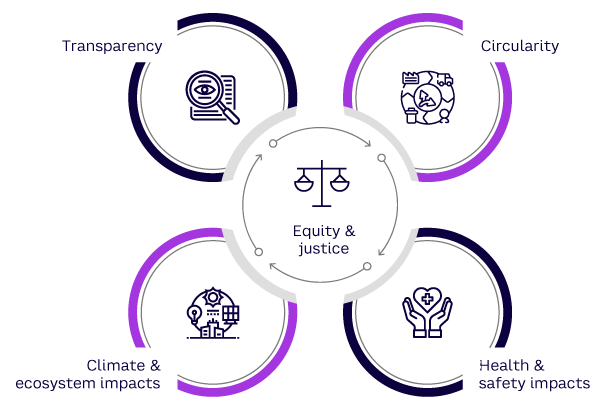AMPLIFY VOL. 37, NO. 4

In the post-COVID world, companies face a host of conflicting demands from consumers, employees, and investors. Customer interest continues to be driven by new channels, such as social media and influencers. Employees are flexing their power with management in ways not seen for decades. Investors continue to demand innovation and growth of both top and bottom lines.
One concern increasingly key to all these groups, albeit expressed differently, is sustainability. Companies are addressing sustainability in a variety of ways, but they often fail to do so in the product-design phase, to their detriment.
A 2023 survey by PDI Technologies of 1,000 US consumers found that 74% consider the environmental impacts of products they buy, and 68% are willing to pay more for products perceived to be environmentally friendly. This is up from 64% in the prior version of the survey two years before, despite inflation and rising prices overall.1 This is especially true of Gen Z (those born between 1997 and 2012), as reported by the World Economic Forum, with three-quarters preferring sustainable brands.2
In addition to being an important consumer group, Gen Z is a growing labor force that companies cannot afford to ignore. Gen Z and Millennial employees increasingly factor climate into their career decisions. A 2024 Bentley University/Gallup report of more than 5,000 Americans shows that 25% of females and 22% of males would be willing to leave their jobs and take a 10% pay cut to work for an organization that had a greater positive impact on society.3 Gen Z is also willing to pressure their employers on environmental issues, highlighting the fact that companies cannot ignore the concerns and preferences of their current and future labor force.
Globally, investors also express a deep interest in sustainability issues. A 2024 report from Morgan Stanley’s Institute for Sustainable Investing shows that 85% of individual investors in the US and Europe and 77% globally are interested in sustainable investing.4 Regardless of the dramatization and politicization of ESG (environment, social, and governance) in the US Congress and the press, investors continue to consider sustainability issues in their decisions.5 US Securities Exchange Commission (SEC) Chair Gary Gensler stated, “Investors representing literally tens of trillions of dollars support climate-related disclosures because they recognize that climate risk can pose a significant financial risk to companies.”6
Upstream Choices, Downstream Effects
Combined, the consumer, employee, and investor pressures mean everyone from executives and corporate boards down to product line managers should consider sustainability as material to their business. In particular, companies that sell physical products must consider the human, environmental, and economic impacts of these products, both upstream in production and downstream during use. For these companies, decisions made in the design phase have long-reaching consequences. When sustainability considerations are incorporated at the end of design (as is the norm), inefficiencies and excess costs may result, as well as a shadow of inauthenticity.
For example, a cursory glance at recent S&P 500 sustainability reports reveals a near-universal interest in addressing carbon emissions and a growing interest in plastic pollution. These concerns are in line with consumer preferences and concerns about climate change and ocean pollution, and both directly result from design choices and processes.
Many of the product-specific sustainability challenges companies face occur at the beginning and end of a product’s lifecycle. For example, for some companies, Scope 3 climate emissions (those captured throughout a company’s entire value chain) can be greater by an order of magnitude than those in Scope 1 and 2.7 In some countries (e.g., US), disclosure of Scope 3 emissions is voluntary; in others, it is already mandatory (e.g., UK).
These downstream effects are the furthest from executives and decision makers and beyond policy setters’ reach. As a result, companies struggle to understand their true impacts, much less manage them, and often feel they have little control over these areas. This results in companies viewing and managing sustainability as a risk, rather than part of larger corporate strategies.
Too often, sustainability efforts come late in the product-design process, appear bolted on, and are relegated to corporate functions far from upstream choices. This may be due to the lack of importance placed on the role itself. A 2023 Weinreb Group survey found that although a third of chief sustainability officers report directly to the CEO, most of the rest report through functions far from product decisions, such as corporate affairs, general counsel, investor relations, or HR.8
To address stakeholders’ sustainability concerns, some companies are marketing the potential of their products to fit within a circular economy. However, doing so using existing products and business models involves significant constraints and often results in solutions that environmentalists call “end of the tailpipe” (treating the symptoms rather than addressing the root cause). Companies that launch recycling programs after years of producing significant amounts of waste and fast-fashion companies that launch resale sites are examples of well-intended but poorly planned sustainability efforts geared toward risk mitigation.
When sustainability efforts are made in haste, companies open themselves up to being accused of “greenwashing” or lacking corporate responsibility. The efforts may be based on an honest commitment to good corporate responsibility and may attempt to address important issues for company stakeholders, but if they are not implemented successfully or communicated transparently, the substandard results and public scrutiny can lead to internal paralysis and resistance to future sustainability efforts.
For example, Keurig, the company behind the ubiquitous K-cup single-serve coffee pods, has long grappled with the issue of waste and recycling. Its efforts to encourage pod recycling in Canada (claiming that peeling off the lid and emptying the grounds made them eligible for recycling) led to both a backlash and government fines.9
Even companies that pride themselves on their corporate social responsibility are not immune to intense criticism for product failures. Johnson & Johnson’s values statement says, “We believe our first responsibility is to the patients, doctors and nurses, to mothers and fathers and all others who use our products and services.” This commitment, as well as the company’s overall reputation, has been called into question due to the company’s involvement in the opioid epidemic and the link between its iconic baby powder and ovarian cancer.
Addressing these complex problems requires a holistic, inclusive approach in which solutions are rooted at the beginning of the process, rather than trying to solve the problem after a product like the single-use coffee pod is already in use. Companies can do this by addressing full value chain sustainability during the product-design process.
Why Product Design Matters
In product-driven companies, the journey toward sustainability and better corporate responsibility should begin with the product-design process. Design choices significantly influence supply chains, the primary source of emissions for many companies. They also impact the attributes of the product during and after its useful life, far down the value chain. Additionally, design specifications such as performance criteria and material selection play pivotal roles in determining the impacts of products and services on people and the planet.
A simple example is the use of polyvinyl chloride (PVC) in product specifications, such as packaging. PVC is used in a variety of products, as well as in clear clamshells, blister packaging, shrink wrap, and food packaging. The choice of PVC for packaging material can link a company’s supply chains to the production and transportation of toxic vinyl chloride, the exposure of workers and consumers to endocrine-disrupting chemicals, an inability to recycle the product, and a disposal pathway that can produce some of the most toxic human-made substances. Consumers share this concern, and many consider the environmental impact of packaging in purchasing decisions.
In many ways, companies evade scrutiny and corporate responsibility because the chemicals, chemical processes, and materials they use in the production of their products are not tested for human safety and are loosely regulated by the federal government. Additionally, because of lax regulation, harmful chemicals are ubiquitous in society and the environment. This continues despite nearly 30 years of evidence of the significant body burden from chemicals in products in our most vulnerable populations and growing evidence of health impacts from chemicals in the environment.10 Given their ubiquity, any harm these chemical entities cause to the environment or humans is unlikely to be traced back to their products.
A recent example is the growing awareness of the risks of PFAS (per-and polyfluoroalkyl substances), which have been used globally in consumer-facing products for decades, often to provide nonstick or stain-resistant properties. Until recently, chemicals were generally regulated one by one, rather than as a group. Since there are nearly 5,000 PFAS, companies have long shifted their product formulations to less widely used members of the PFAS family to evade scrutiny and slow-moving regulations.
For example, the outdoor industry has long relied on waterproof protection from PFAS. Many companies shifted their formulations over the last decade from C8 PFAS to lesser-known C6 PFAS and then to C4 PFAS formulations. Although research is ongoing about the full extent of human-health impacts, the US Center for Disease Control and Prevention (CDC) reports that PFAS exposure has been connected to high cholesterol levels, poor liver function, some cancers, and low birth weight.11 In response, the EPA is taking actions to reduce PFAS exposure, including enhanced reporting of PFAS production, use, and release, as well as new drinking water standards.12
New Framework for Corporate Responsibility via Product Design
Recently, an interdisciplinary group of 20 experts from industry, government, academia, and nonprofits developed a framework for a more sustainable product development process.13 The group’s mission was to establish a definition for the field of sustainable chemistry, but the results are directly applicable to a holistic, sustainable product development process.
The framework’s categories include equity and justice, transparency, health and safety impacts, circularity, and climate and ecosystem impacts (see Figure 1). Although it is not prescriptive, the framework provides a new modality for guiding the thought process in design by embedding considerations of safer materials and better working environments, as well as open and honest communication on product content — all with the goal of more sustainable products.
When done correctly, this method can lead to circularly designed products: those with end-of-life and product-renewal plans. Note that the business model to support the circularity is put in place up front, rather than bolted on at the end. In addition, eliminating toxins in the product-design phase reduces the chances of toxin exposure for workers and consumers throughout the value chain.

Current design paradigms often focus on profitability, particularly the twin drivers of cost minimization and market maximization. This approach results in the exclusion of sustainability considerations in the design phase. Using the proposed framework would result in an inclusive design process that embodies the essence of corporate responsibility. Products would be built only after authentically engaging with stakeholders and verifying the protection of workers and marginalized groups along the value chain. Greenhouse gas emissions would be specified alongside chemical and material safety data and included in the chain of custody. Chemicals and materials used in production would be selected for their lack of hazards and preferentially incorporated into circular products.
As companies work toward a product-design process that encompasses a commitment to corporate responsibility, they must be transparent about their goals, the steps they are taking, and where they are in the journey. If companies choose to immediately market their initial efforts as sustainable, they will open themselves up to greenwashing claims. In fact, there are recent calls to abandon the use of the term “sustainability” altogether due to misuse by companies, particularly those in the fashion industry.14
The Future of Corporate Responsibility
The future of corporate responsibility is intrinsically tied to the product-design process. As companies strive to address their products’ environmental and societal impacts, they must shift from reactive sustainability efforts to proactive integration of sustainability principles into their design processes.
This shift requires a holistic approach that considers all stakeholders and prioritizes transparency, equity, and justice. By doing so, companies can avoid greenwashing accusations while meeting the needs of consumers, employees, and investors. This transformation is not just an ethical imperative but a strategic necessity in a world increasingly conscious of the environmental and social footprints of products.
References
1 “Report Shows Consumers Want Sustainable Products.” PDI Technologies, 26 April 2023.
2 Wood, Johnny. “Gen Z Cares About Sustainability More Than Anyone Else — and Is Starting to Make Others Feel the Same.” World Economic Forum, 18 March 2022.
3 “Business in Society Report.” Bentley University/Gallup, accessed April 2024.
4 “Individual Investors’ Interest in Sustainability Is on the Rise.” Morgan Stanley, 2024.
5 Warner, Bernhard. “Investors Pull Billions from Sustainable Funds Amid Political Heat.” The New York Times, 19 January 2024.
6 “Climate-Related Disclosures/ESG Investing.” US Securities and Exchange Commission (SEC), 7 March 2024.
7 Greenhouse Gas Protocol website, accessed April 2024.
8 “2023 Weinreb Group Chief Sustainability Officer Report.” Weinreb Group, 2023.
9 Competition Bureau Canada. “Keurig Canada to Pay $3 Million Penalty to Settle Competition Bureau’s Concerns Over Coffee Pod Recycling Claims.” Press release, Government of Canada, 6 January 2022.
10 “Body Burden: The Pollution in Newborns.” Environmental Working Group (EWG), 14 July 2005.
11 “NTP Monograph: Immunotoxicity Associated with Exposure to Perfluorooctanoic Acid or Perfluorooctane Sulfonate.” National Toxicology Program (NTP), US Department of Health and Human Services (HHS), September 2016.
12 “Biden-Harris Administration Finalizes First-Ever National Drinking Water Standard to Protect 100M People from PFAS Pollution.” Press release, US Environmental Protection Agency (EPA), 10 April 2024.
13 “Definition and Criteria for Sustainable Chemistry.” Expert Committee on Sustainable Chemistry (ECOSChem), February 2023.
14 Pucker, Kenneth P. “The Myth of Sustainable Fashion.” Harvard Business Review, 13 January 2022.




